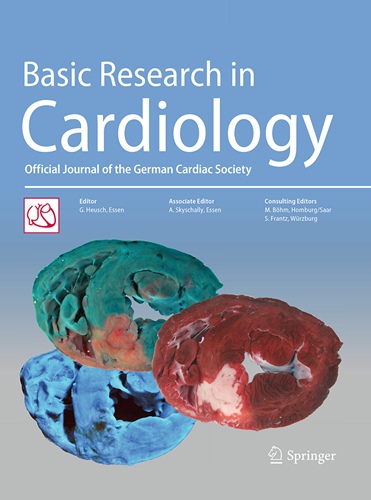Myocardial phosphoproteomics unveils a key role of DYRK1A in aortic valve replacement-induced reverse remodelling.
IF 8
1区 医学
Q1 CARDIAC & CARDIOVASCULAR SYSTEMS
引用次数: 0
Abstract
Aortic valve stenosis (AVS) is a growing healthcare burden. Aortic valve replacement (AVR) remains the only effective treatment to eliminate pressure overload and triggers myocardial reverse remodelling (RR), with regression of hypertrophy, fibrosis and diastolic function normalisation. However, many patients show an incomplete RR, being at higher risk of death. We aimed to uncover pathways and new therapeutic targets for incomplete RR through myocardial (phospho)proteomics. AVS patients were categorised based on left ventricle mass regression (LVM): complete RR (≥ 15%) or incomplete RR (≤ 5%). 83 myocardial proteins were dysregulated through LC-MS/MS. Gene ontology enrichment analysis identified inflammation, complement and immune system activation as priming events of an incomplete RR and a better mitochondrial function underscoring complete RR. Kinetic metabolic modelling corroborated the lower ATP production capacity of incomplete RR patients. To uncover therapeutic targets, kinases were predicted from phosphoproteome data. Casein kinase 2 and DYRK1A were among the most dysregulated kinases in RR. DYRK1A was found to be inversely correlated with LVM regression (r = - 0.62). DYRK1A functional role (passive, maximal tension and Ca2+ sensitivity) was evaluated in skinned cardiomyocytes from Dyrk1a+/- mice and from AVS patients upon incubation with this kinase. Cardiomyocytes from mutant mice showed increased myofilamentary stiffness in response to stretch. Also, the raised myofilamentary stiffness of cardiomyocytes isolated from incomplete RR was normalised upon incubation with DYRK1A. Better myocardial bioenergetics may underscore a complete LVM regression. In turn, complement and immune-inflammatory pathways activation prime an incomplete response to AVR. DYRK1A emerges as a surrogate target to treat myocardial stiffness-driven diastolic dysfunction.心肌磷酸化蛋白质组学揭示了DYRK1A在主动脉瓣置换术诱导的反向重构中的关键作用。
主动脉瓣狭窄(AVS)是一个日益增长的医疗负担。主动脉瓣置换术(AVR)仍然是消除压力过载和触发心肌反向重构(RR)的唯一有效治疗方法,可使肥厚、纤维化和舒张功能恢复正常。然而,许多患者表现为不完全RR,死亡风险较高。我们旨在通过心肌(磷)蛋白质组学揭示不完全RR的通路和新的治疗靶点。根据左心室质量回归(LVM)对AVS患者进行分类:完全RR(≥15%)或不完全RR(≤5%)。LC-MS/MS检测83种心肌蛋白表达异常。基因本体富集分析发现,炎症、补体和免疫系统激活是不完全RR和更好的线粒体功能强调完全RR的启动事件。动力学代谢模型证实了不完全RR患者较低的ATP生产能力。为了发现治疗靶点,从磷酸化蛋白质组数据预测激酶。酪蛋白激酶2和DYRK1A是RR中最失调的激酶。DYRK1A与LVM回归呈负相关(r = - 0.62)。在DYRK1A +/-小鼠和AVS患者的皮肤心肌细胞中,用该激酶孵育后,评估了DYRK1A的功能作用(被动、最大张力和Ca2+敏感性)。来自突变小鼠的心肌细胞在拉伸反应中表现出肌纤维硬度增加。此外,与DYRK1A孵育后,从不完全RR中分离的心肌细胞的肌纤维硬度升高得到正常化。更好的心肌生物能量学可能强调LVM的完全回归。反过来,补体和免疫炎症途径的激活引发了对AVR的不完全反应。DYRK1A成为治疗心肌僵硬性舒张功能障碍的替代靶点。
本文章由计算机程序翻译,如有差异,请以英文原文为准。
求助全文
约1分钟内获得全文
求助全文
来源期刊

Basic Research in Cardiology
医学-心血管系统
CiteScore
16.30
自引率
5.30%
发文量
54
审稿时长
6-12 weeks
期刊介绍:
Basic Research in Cardiology is an international journal for cardiovascular research. It provides a forum for original and review articles related to experimental cardiology that meet its stringent scientific standards.
Basic Research in Cardiology regularly receives articles from the fields of
- Molecular and Cellular Biology
- Biochemistry
- Biophysics
- Pharmacology
- Physiology and Pathology
- Clinical Cardiology
 求助内容:
求助内容: 应助结果提醒方式:
应助结果提醒方式:


